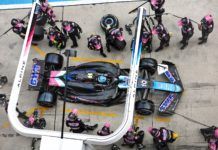Haas’ Guenther Steiner feels the F1 races should be shortened by three laps so as to allow the teams run to their full extent and not worry about the fuel limit.
The F1’s US GP saw teams and drivers having to manage their way in terms of fuel limit which eventually caught Haas’ Kevin Magnussen out as he used 170 gm more than the set limit of 105 kg which led to his disqualification from the race.
The team admitted that they hoped they will have to do one lap less with the leaders lapping them but with the top runners themselves in fuel saving mode, they didn’t lap Magnussen who had originally finished ninth.
The Dane wasn’t really happy after the race and also at the start of the Mexico GP weekend. The fuel limit is to increase to 110 kg in the next F1 season but Haas’ Steiner feels it will be better to cut the laps from the total race distance.
He thinks that is the best way because it will not need the team to design a new fuel cell to hold the new limit which will help everyone to save money. “We were not clever enough to manage the fuel and I’m not trying to find an excuse for what we did,” said Steiner.
“We fought hard and we deal with the consequences, we are fully OK with that – but I think if we would shorten the race, for example, leave the regulations where they are so we don’t have to spend money to design new fuel cells or whatever, just reduce the race three laps, you would have wide open racing the whole race.
“I think there you would have more overtaking than by lift-and-coast. If anybody listens in to radio at the moment, to the drivers, 80 per cent is about lift-and-coast. And again, if somebody then decides to put less fuel in, it could be part of the strategy, he can decide that – but it’s on his own behalf.
“If we would have fuel to go the whole race, that you can race as the race car is built to do. A race car, in my opinion, is built to race a full race, and not to save fuel. That’s my opinion about racing. And it could be easily achieved.
“I think nobody would miss if we make the races three laps shorter, where we make a procession anyway because we have to fuel-save. So, again, that’s my opinion on it. I just want to make it clear to everybody I’m not trying to make an excuse for what happened to us last week.
“We made a mistake and we got the points taken away and we live with that one.” His colleagues though feel that fuel saving has been part of the show for years and the US GP was nothing new in that aspect.
In fact, some use it as strategy in the races – which sometimes works and sometimes doesn’t as it was seen in Austin. “It is a regulation and it’s been with us for quite some time,” said Racing Point Force India’s Otmar Szafnauer.
“Even if you don’t have those fuel limits, we will always be making trade-offs between how much fuel we put in the car, such that we get to the end in the shortest amount of time. Even in the past, where you don’t have a fuel limit, you fuel it to the point where your total race time is lowest – and that sometimes means fuel saving.
“And, to the contrary, if we’re fuel-saving, at a different time to when somebody else is, it could help overtaking. You know, I think Haas maybe didn’t do the fuel saving when they were trying to attack us but if there is a time in the race, and it often happens, somebody’s fuel saving when we aren’t, that’s a good time to attack.
“So, you see, it can help with overtaking. Just the opposite.” Toro Rosso’s Franz Tost cited the example of the time when Alain Prost pushed too hard which left him with no fuel during 1986 German GP which meant he had to push his car to the finish line.
“That’s within the regulation and it’s not new that in F1 you have to save fuel,” he said. “Remember back with Prost, was it, at Hockenheim, when he had to push his car when it ran out of fuel. So, it’s within the regulations and you have to respect it.
“You will never have enough fuel or tyres that you can race, let me say 60 laps all on the limit. That’s simply not possible, yes? We all know this, and it depends then how clever the driver is, how clever the team operates to stay within the regulations.”



















